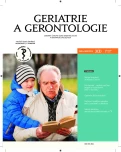Positioning – an essential part of therapy and everyday care for a patient
Authors:
Mgr. Jana Tomsová 1; Mgr. Anna Zelená 2
Authors‘ workplace:
Oddělení rehabilitace LF UP a FN Olomouc
1; Ústav fyzioterapie FZV UP Olomouc
2
Published in:
Geriatrie a Gerontologie 2014, 3, č. 3: 118-122
Category:
Overview
The issue of caring for an immobile patient relates not only to the immediate securing of vital functions. It represents a comprehensive approach with effort to allow the patient to return to full daily activities as soon as possible. To minimize the effects of immobilization, which has a negative impact on a wide range of physical systems are, used, inter alia positioning that has an immediate impact on respiratory function and muscle tone. For positioning of the patient it is necessary to respect the functional status of limbs and to use stable and unstable positions including vertical position. The aim of this paper is to offer the possibility of positioning with respect to the mentioned context.
Keywords:
positioning – pressure ulcer – patient – pneumonia
Sources
1. Barnet RI, Shelton FE: Measurement of support surface efficacy: pressure. Adv Wound Care 1997; 10: 21–29.
2. Breuls RG, Bouten CV, Oomens CW et al.: Compression induced cell damage in engineered muscle tissue: an in vitro model to study pressure ulcer aetiology. Ann Biomed Eng 2003; 31: 1357–1364.
3. Burk RSI, Grap MJ: Backrest position in prevention of pressure ulcers and ventilator-associated pneumonia: conflicting recommendations. Heart Lung 2012; 41(6): 536–545.
4. Husain T: An experimental study of some pressure effects on tissues, with reference to the bed-sore problem. J Pathol Bacteriol. 1953; 66: 347–358.
5. Kolář P et al.: Rehabilitace v klinické praxi. Praha: Galén 2009.
6. Kosiak M: Etiology of decubitus ulcers. Arch Phys Med Rehabil 1961; 42: 19–29.
7. Linder Ganz E, Gefen A: Mechanical compression-induced pressure sores in rat hindlimb: muscle stiffness, histology, and computational models. J Appl Physiol 2004; 96: 2034–2049.
8. Meluzínová H, Weber P, Navrátilová Z, Kubešová H: Dekubitus – jak dále v diagnostice, prevenci a léčbě? Klinická farmakologie a farmacie 2006; 3; 144–149.
9. Peterson M, Schwab W, Mccutcheonk K et al.: Effects of elevating the head of bed on interface pressure in volunteers. Crit Care Med 2008; 36: 3038–3042.
10. Reichel SM: Shearing force as a factor in decubitus ulcers in paraplegics. J Am Med Assoc 1958; 166: 762–763.
11. Still MD, Cross LC, Dunlap M et al.: The turn team: a novel strategy for reducing pressure ulcers in the surgical intensive care unit. J Am Coll Surg 2013; 216(3): 373–379.
Labels
Geriatrics General practitioner for adults Orthopaedic prostheticsArticle was published in
Geriatrics and Gerontology

2014 Issue 3
Most read in this issue
- Surgical treatement of pressure ulcers
- Positioning – an essential part of therapy and everyday care for a patient
- Consumption increase of psychogeriatric care in Czech Republic
- Monitoring pressure ulcers on national level – prevalence monitoring of occurrence and risk of pressure ulcers
